Note
Go to the end to download the full example code
Iterated Masked sifting#
Masking signals are a powerful method for reducing the mode mixing problem when running EMD on noisy or transient signals. However, the standard methods for selecting masks often perform poorly in real data and selecting masks by hand can be cumbersome and prone to error.
This tutorial introduces iterated masking EMD (itEMD), a recent sifting method that automates mask signal frequencies based on the dynamics present in the data. We will show how it automatically dentifies oscillations and minimises mode mixing without prespecification of masking signals.
The method is published in the following paper:
Marco S. Fabus, Andrew J. Quinn, Catherine E. Warnaby, and Mark W. Woolrich (2021). Automatic decomposition of electroptysiological data into distinct nonsinusoidal oscillatory modes. Journal of Neurophysiology 2021 126:5, 1670-1684. https://doi.org/10.1152/jn.00315.2021
Issues with Mask Selection#
Let’s start by simulating a signal with a 2Hz nonsinusoidal oscillation and 30Hz beta bursts.
import numpy as np
import matplotlib.pyplot as plt
import emd
np.random.seed(0)
sample_rate = 256
seconds = 3
num_samples = sample_rate*seconds
time_vect = np.linspace(0, seconds, num_samples)
# Create an amplitude modulation
freq = 2
am = np.sin(2*np.pi*freq*time_vect)
am[am < 0] = 0
# Non-sinusoidal intermittend 2Hz signal
x1 = np.sin(np.sin(np.sin(np.sin(np.sin(np.sin(np.sin(2*np.pi*freq*time_vect))))))) / 0.5
# Bursting 30Hz oscillation
x2 = am * 0.5 * np.cos(2*np.pi*30*time_vect)
# Sum them together
x = x1 + x2
# Quick summary figure
plt.figure(figsize=(8, 4))
plt.plot(time_vect, x)
plt.xlim(0, 3)
# sphinx_gallery_thumbnail_number = 6
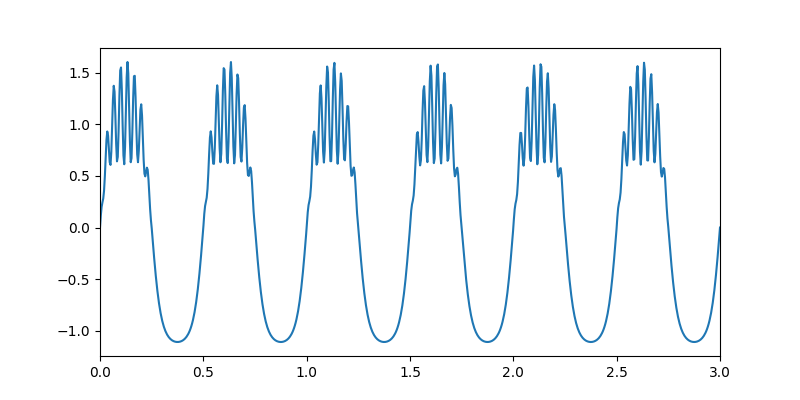
(0.0, 3.0)
Let’s run the default mask sift, where mask frequency is determined from zero crossings of the signal.
imf = emd.sift.mask_sift(x, max_imfs=4)
emd.plotting.plot_imfs(imf)
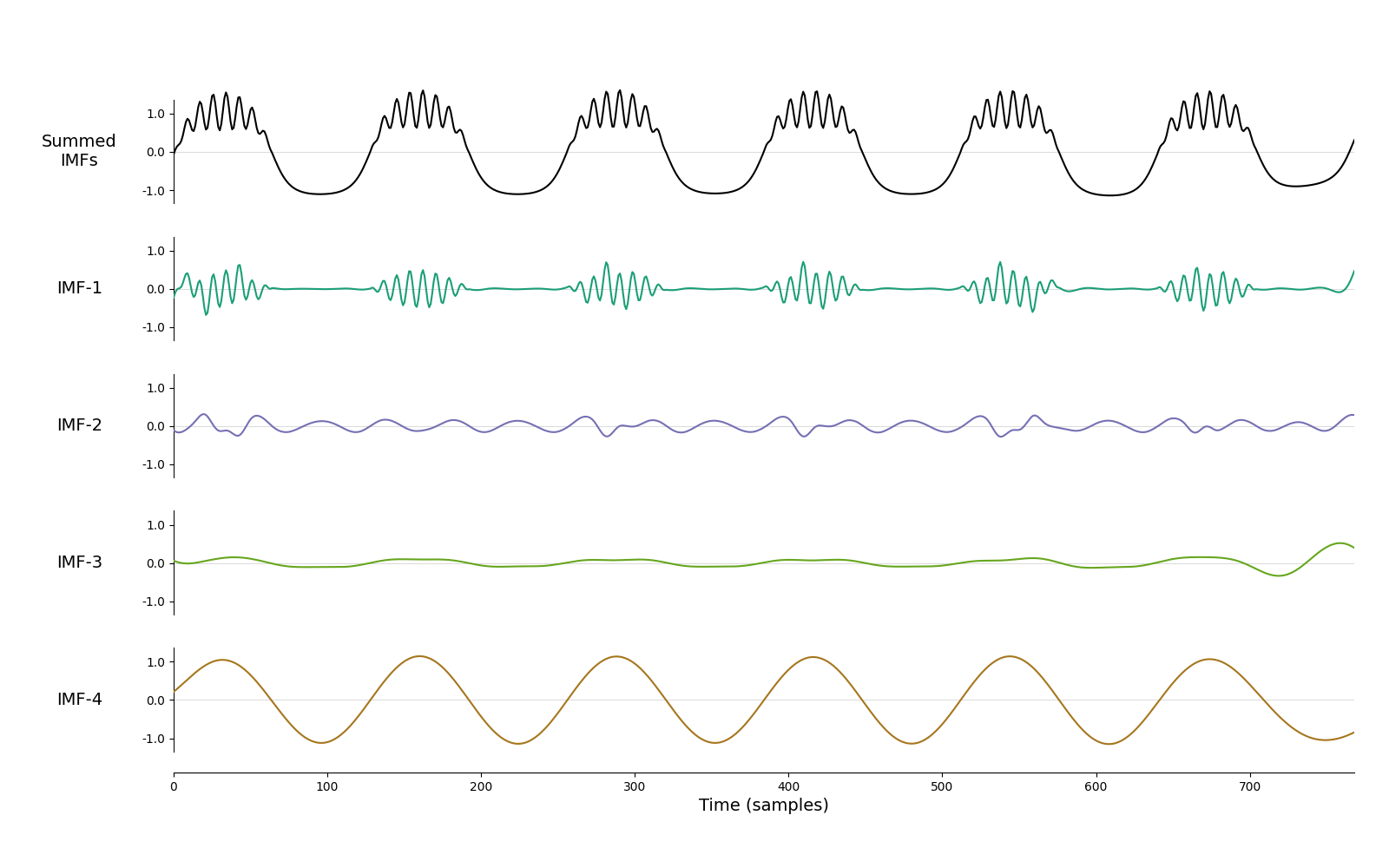
<Axes: xlabel='Time (samples)'>
We can see that the result is not great. Bursting beta is in IMF-1, but the non-sinusoidal oscillation is split between IMF-2 and IMF-4. This is because the waveform is highly non-sinusoidal and spans a lot of frequencies, confusing the default mask sift. Let’s try the same thing, but now with custom mask frequencies.
mask = np.array([60, 30, 24, 2, 1, 0.5])/sample_rate
imf = emd.sift.mask_sift(x, max_imfs=5, mask_freqs=mask)
emd.plotting.plot_imfs(imf, time_vect=time_vect)
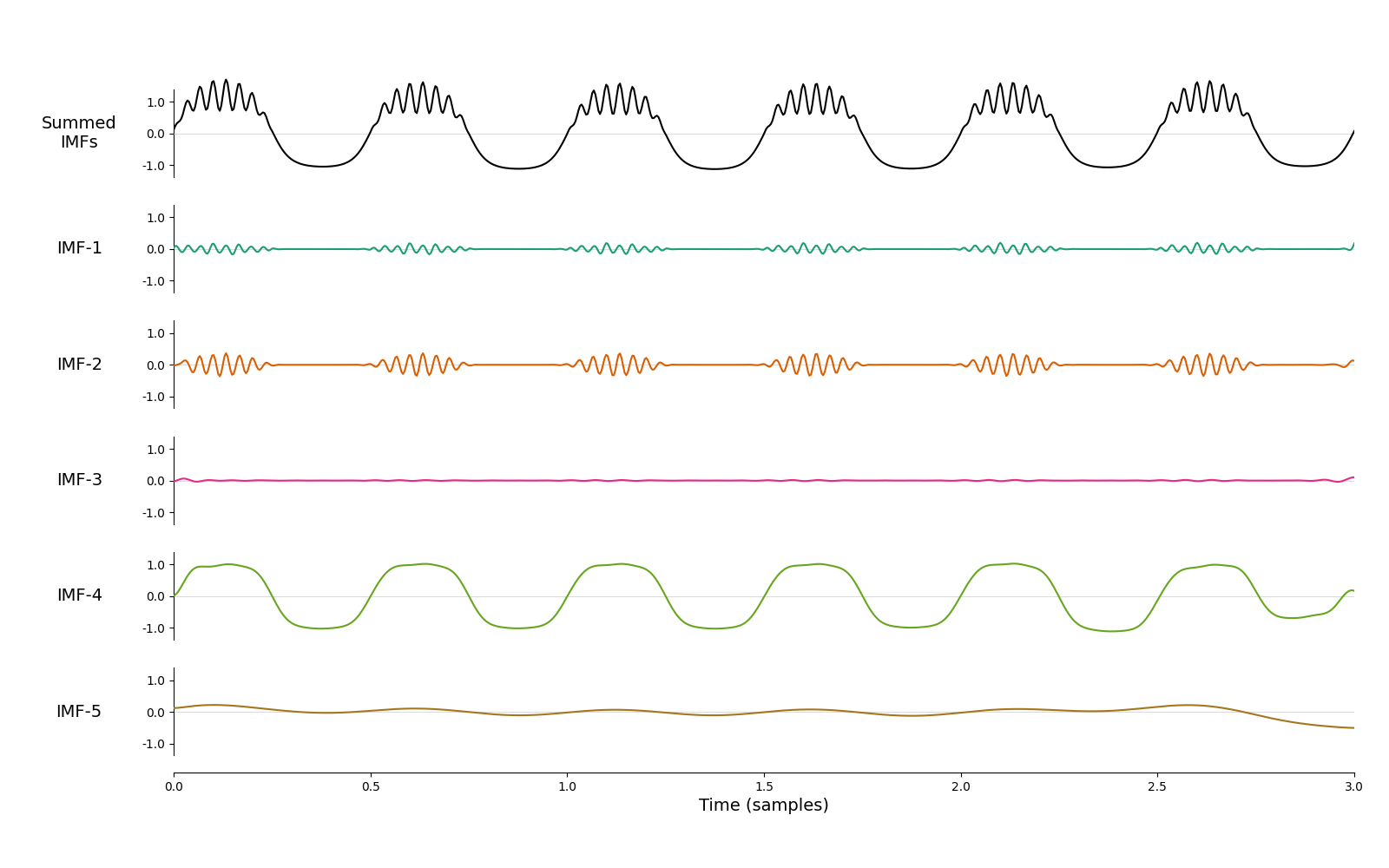
<Axes: xlabel='Time (samples)'>
Better! Most of the 2Hz oscillation is now in IMF-4 and most of bursting beta in IMF-2. However, it’s still not perfect - beta is slightly split between IMF-1 and IMF-2 and we have an unnecessary ‘empty’ mode IMF-3. Finding a mask that balances all of these issues can be an arduous manual process. How could we do this automatically? Let’s come back to our original sift and look at the mean instantaneous frequencies of the modes weighted by instantaneous amplitude.
imf = emd.sift.mask_sift(x, max_imfs=4)
IP,IF,IA = emd.spectra.frequency_transform(imf, sample_rate, 'nht')
print(np.average(IF, 0, weights=IA**2))
[27.04427481 6.20693296 1.63994241 1.9635715 ]
Automated Mask Selection#
Even though the modes are split, frequencies of the first two modes are close to the ground truths of 30Hz and 2Hz that we know. What happens if we take these frequencies as the mask for masked sift?
# Compute the default mask sift
imf = emd.sift.mask_sift(x, max_imfs=4)
# Take the mean IF as new mask, compute mask sift again and plot
IP,IF,IA = emd.spectra.frequency_transform(imf, sample_rate, 'nht')
mask_1 = np.average(IF, 0, weights=IA**2) / sample_rate
imf = emd.sift.mask_sift(x, max_imfs=4, mask_freqs=mask_1)
emd.plotting.plot_imfs(imf, time_vect=time_vect)

<Axes: xlabel='Time (samples)'>
We have now removed the empty mode and the bursting beta in is entirely IMF-1. It’s certainly an improvement on the default sift. Let’s repeat this process ten times and track what happens to average frequencies of the first two IMFs.
# Compute the default mask sift
imf, mask_0 = emd.sift.mask_sift(x, max_imfs=4, ret_mask_freq=True)
# Take the mean IF as new mask, compute mask sift again and plot
IP,IF,IA = emd.spectra.frequency_transform(imf, sample_rate, 'nht')
mask = np.average(IF, 0, weights=IA**2) / sample_rate
# Save all masks:
mask_all = np.zeros((3, 12))
mask_all[:, 0] = mask_0[:3]
mask_all[:, 1] = mask[:3]
for i in range(10):
imf = emd.sift.mask_sift(x, max_imfs=4, mask_freqs=mask)
IP,IF,IA = emd.spectra.frequency_transform(imf, sample_rate, 'nht')
mask = np.average(IF, 0, weights=IA**2) / sample_rate
mask_all[:, i+2] = mask[:3]
plt.figure()
for i in range(2):
plt.plot(mask_all[i, :]*sample_rate)
plt.xlabel('Iteration #')
plt.ylabel('Mask frequency [Hz]')
plt.show()
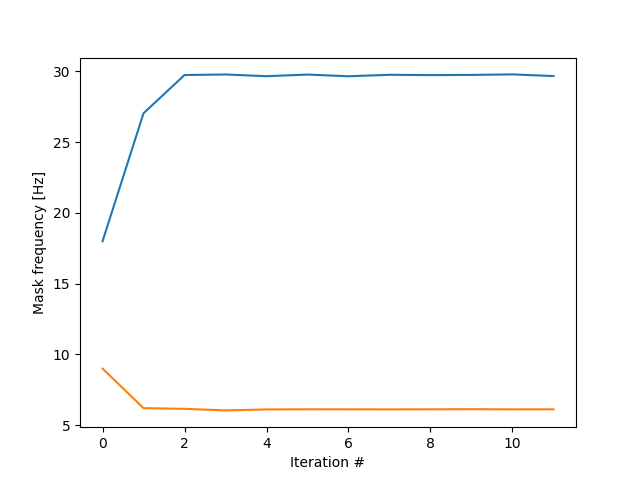
The iteration process rapidly converged on the ground truth frequencies, 2Hz and 30Hz! This is the essence of iterated masking EMD (itEMD). By finding the equilibrium between masks and IMF frequencies, we automatically extract oscillations of interest in a data-driven way. Let’s apply itEMD directly and show the result.
imf = emd.sift.iterated_mask_sift(x, sample_rate=sample_rate, max_imfs=3)
emd.plotting.plot_imfs(imf)
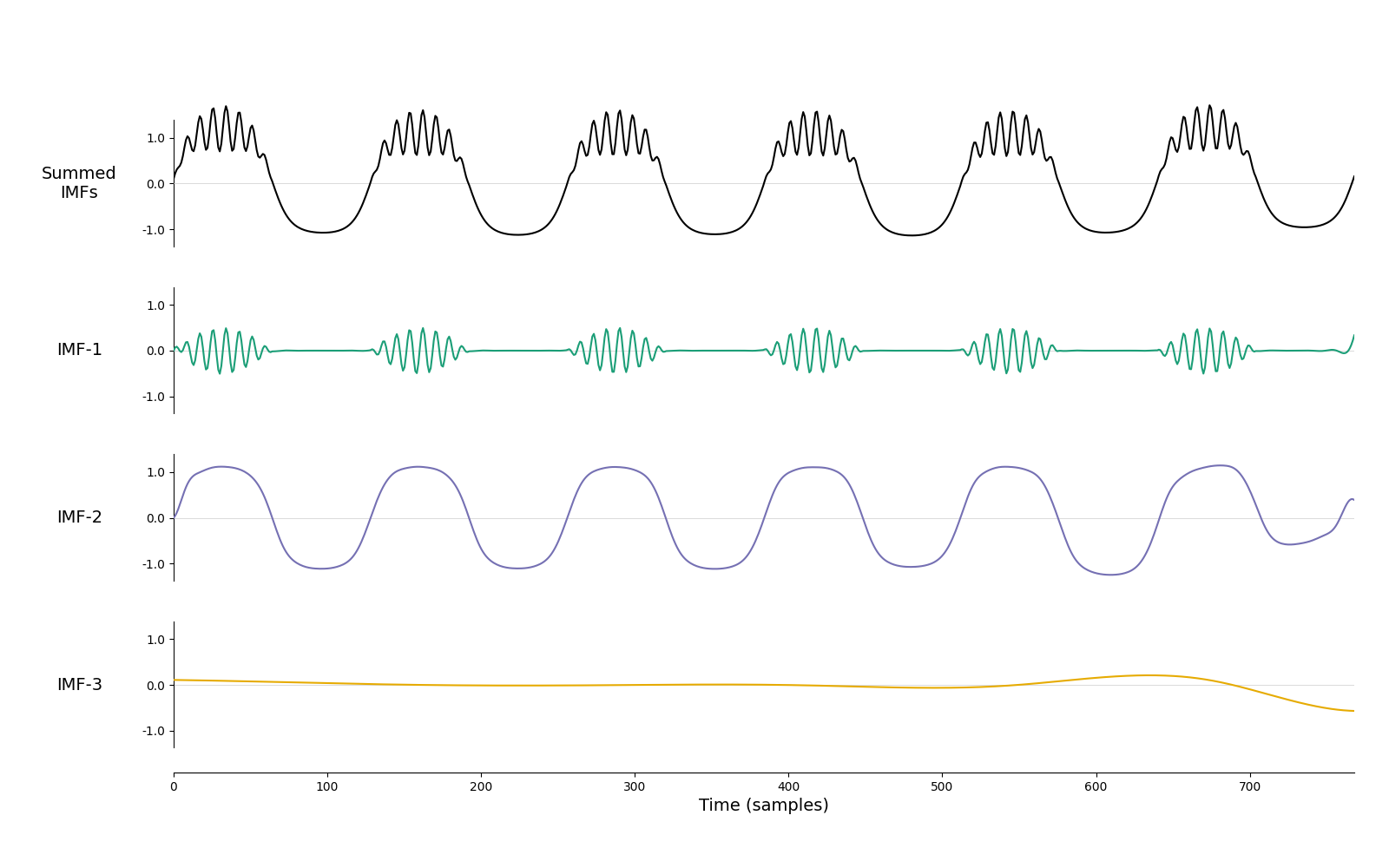
<Axes: xlabel='Time (samples)'>
And that’s it! We have identified both the bursting beta and a non-sinusoidal oscillation automatically and without ‘empty’ modes between them.
This decomposition has a clear Hilbert-Huang transform in the amplitude modulations of the 30Hz signal and within-cycle instantaneous frequency variability of the 2Hz signal are clearly visible.
IP, IF, IA = emd.spectra.frequency_transform(imf, sample_rate, 'nht')
f, hht = emd.spectra.hilberthuang(IF, IA, (1, 50, 49, 'log'), sum_time=False)
plt.figure(figsize=(8,4))
ax = plt.subplot(111)
emd.plotting.plot_hilberthuang(hht, time_vect, f,
log_y=True, cmap='ocean_r',
ax=ax, time_lims=(0.5, 2))
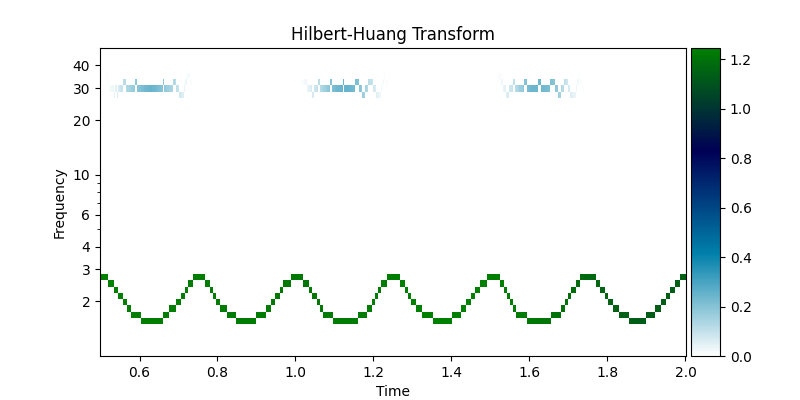
<Axes: title={'center': 'Hilbert-Huang Transform'}, xlabel='Time', ylabel='Frequency'>
Oscillations in Noise#
Lets take a look at how itEMD performs on a couple of noisy signals. Here we look at a dynamic 15Hz oscillation embedded in white noise. The itEMD is able to isolate the oscillation into a single component.
# Define and simulate a simple signal
peak_freq = 15
sample_rate = 256
seconds = 3
noise_std = .4
x = emd.simulate.ar_oscillator(peak_freq, sample_rate, seconds,
noise_std=noise_std, random_seed=42, r=.96)[:, 0]
x = x*1e-4
imf = emd.sift.iterated_mask_sift(x, sample_rate=sample_rate, max_imfs=3)
emd.plotting.plot_imfs(imf)
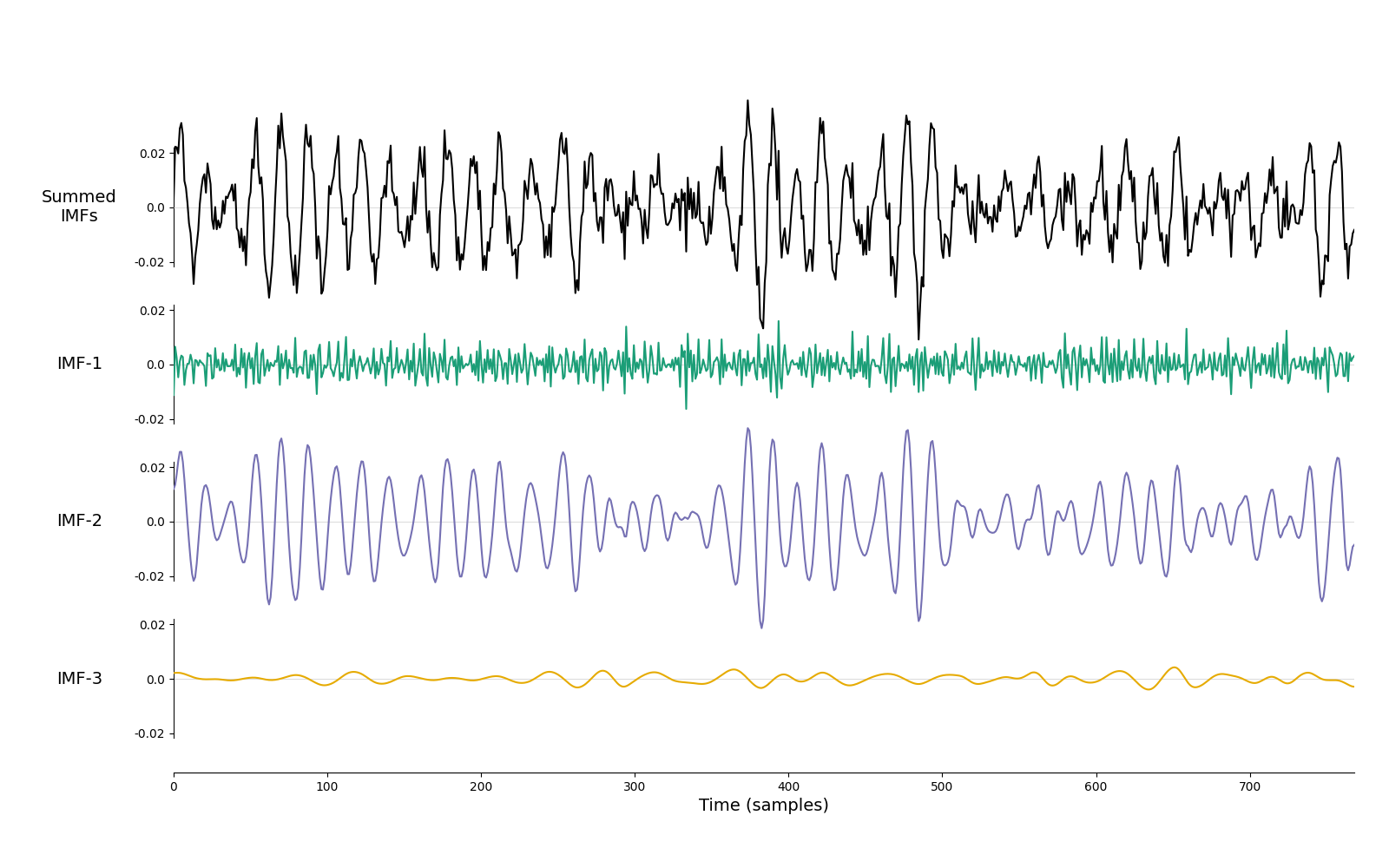
<Axes: xlabel='Time (samples)'>
And, finally, we look at the how iterated mask sifting handles the signal from the Holospectrum tutorial. This case contains several oscillations with complex amplitude modulations. These are nicely separated into two IMFs.
seconds = 4
sample_rate = 200
t = np.linspace(0, seconds, seconds*sample_rate)
# First we create a slow 4.25Hz oscillation with a 0.5Hz amplitude modulation
slow = np.sin(2*np.pi*5*t) * (.5+(np.cos(2*np.pi*.5*t)/2))
# Second, we create a faster 37Hz oscillation that is amplitude modulated by the first.
fast = .5*np.sin(2*np.pi*37*t) * (slow+(.5+(np.cos(2*np.pi*.5*t)/2)))
# We create our signal by summing the oscillation and adding some noise
x = slow+fast + np.random.randn(*t.shape)*.05
imf = emd.sift.iterated_mask_sift(x, sample_rate=sample_rate, max_imfs=5)
emd.plotting.plot_imfs(imf)

<Axes: xlabel='Time (samples)'>
Depending on the nature of the data, some itEMD options may need to be modified. For instance, the max_iter argument can be increased if itEMD reaches the maximum number of iterations, or iter_th can be modified to make the convergence criterion more stringent.
To isolate very transient and infrequent oscillations, it may be a good idea to try different instantaneous amplitude weighting for the iteration process (keyword argument w_method). Finally, if the data is non-stationary such that different masks might be appropriate for different segments of the signal then the time-series should first be segmented and itEMD applied to quasi-stationary segments as it assumes one equilibrium can be found.
For more information, see the documentation for emd and Fabus et al (2021) Journal of Neurophysiology..
Further Reading & References#
Marco S. Fabus, Andrew J. Quinn, Catherine E. Warnaby, and Mark W. Woolrich (2021). Automatic decomposition of electroptysiological data into distinct nonsinusoidal oscillatory modes. Journal of Neurophysiology 2021 126:5, 1670-1684. https://doi.org/10.1152/jn.00315.2021
Total running time of the script: (0 minutes 2.602 seconds)
